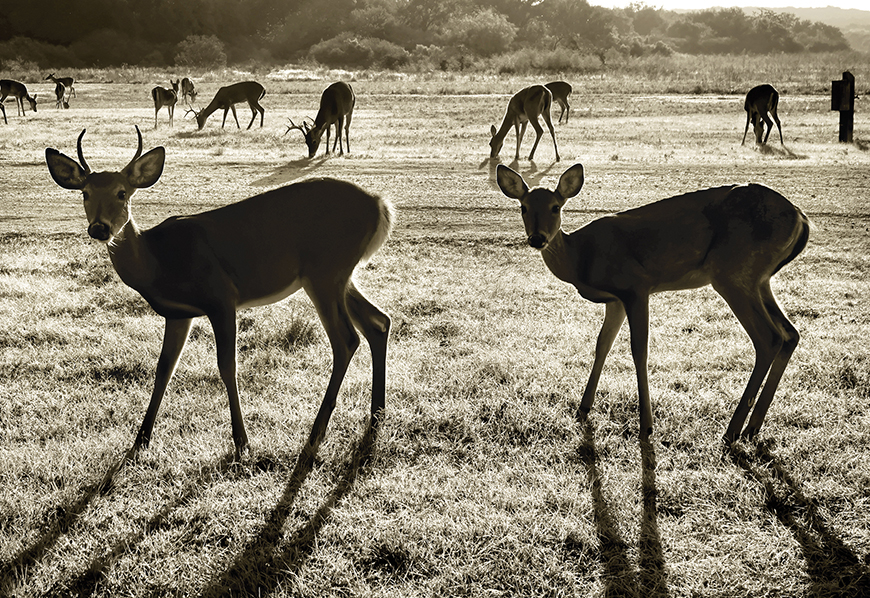Landowners in certain parts of the state need to be aware of chronic wasting disease, which can greatly reduce the number of deer. While there are no known cures or ways to eradicate the disease, the Texas Parks and Wildlife Department is taking measures to reduce its spread.
A multitude of risks threaten to undermine Texas landowners’ efforts to manage their land. Some of those spring from past activities but can leave invisible living legacies behind. Anthrax, for example. An outbreak of anthrax in livestock leaves a scattering of spores across the countryside that can activate and infect replacement herds.
Chronic wasting disease (CWD) in wildlife poses a similar potential problem for landowners in certain parts of Texas. CWD infects members of the Cervidae family, namely deer, elk, moose, etc. CWD does not pose dangers to livestock, and scientists have not found evidence of the disease infecting humans. However, it is always fatal to stricken wildlife, threatening a destructive wave of infections among deer herds where the disease has spread. Therefore, CWD poses a direct threat to one of the primary motives for owning rural land: wildlife herd management.
Profiling CWD
CWD belongs to a family of disorders known as prion diseases, or transmissible spongiform encephalopathies (TSEs). It includes Creutzfeldt-Jakob disease in humans and bovine spongiform encephalopathy, or mad cow disease, in cattle. The
Centers for Disease Control and Prevention describes these maladies in detail:
The causative agents of TSEs are believed to be prions. The term “prions” refers to abnormal, pathogenic agents that are transmissible and are able to induce abnormal folding of specific normal cellular proteins called prion proteins that are found most abundantly in the brain. The functions of these normal prion proteins are still not completely understood. The abnormal folding of the prion proteins leads to brain damage and the characteristic signs and symptoms of the disease. Prion diseases are usually rapidly progressive and always fatal.
CWD symptoms include dramatic weight loss, stumbling, listlessness, decreased social interaction, loss of fear of humans, and excessive salivating. However, animals typically exhibit no symptoms until 18-24 months after contracting the disease. In addition, these symptoms could be caused by other conditions, so formal testing is needed to reliably diagnose CWD.
Obviously, an infected animal may spread the disease to other members of the herd during the nonsymptomatic phase of infection. Perhaps even worse, the body casts off prions, so an infected animal will cast off diseased prions. Therefore, an infected herd can leave infection in the soil and remain infectious to host animals, much like anthrax.
CWD Comes to Texas
Scientists first identified CWD in mule deer in Colorado in 1967. Since that time, CWD has spread to Wyoming, Montana, Wisconsin, Pennsylvania, and other states.
CWD first appeared in Hudspeth County in 2012 in free-ranging mule deer. In 2015, the Texas Parks and Wildlife Department (TPWD) found CWD in white-tailed deer in captive facilities in Medina County. By 2021, a total of 224 cases had been identified in 13 counties. Tests confirmed cases in two red deer, four elk, 49 mule deer, and 169 white-tailed deer.
See the
TPWD site for details. Texas A&M AgriLife Extension provides a good overview of the disease in
A Guide to Chronic Wasting Disease (CWD) in Texas Cervids.
Containing the Spread
Currently, there is no known cure for the disease nor any mechanism to eradicate it. Therefore, TPWD management of CWD seeks to contain the spread to areas of confirmed infections.
The plan has established five CWD zones with confirmed infections: Kimble County Zone, Trans-Pecos Zone, South Central Zone, Panhandle Zone, and Val Verde County Zone. The latest edition of the TPWD
Outdoor Annualprovides maps of each zone indicating official stations performing testing for CWD. All hunters harvesting animals in these zones must take them to one of these stations to have them tested for CWD within 48 hours of the harvest. In addition, hunters can transport carcasses out of the zones only after all brain and spinal cord tissue have been removed. TPWD will provide a receipt for the sample.
Because the spread of CWD is evolving, regulations can change quickly. Therefore, anyone involved in hunting activity should consult the most recent
Outdoor Annual for the latest regulations. To reduce the chances of spreading the disease, TPWD regulations also restrict the movement of live deer from CWD zones.
Impact on Rural Landowners
CWD poses a significant threat to the future of hunting in Texas. Deer population declines of 45 and 50 percent have been documented in Colorado and Wyoming. A broad infection of Texas deer populations resulting in similar population impacts would inflict severe economic damage to rural communities and could negatively impact land markets. Specifically, those landowners seeking to establish a thriving herd of deer could avoid buying in areas with confirmed CWD infections.
As they do with anthrax-susceptible properties, land brokers may find it advisable to inquire about the status of CWD infections on properties that they present for sale. Prospective buyers should also investigate the status of the wildlife on prospective properties. In addition, existing landowners should monitor developments as TPWD crafts management strategies to identify and contain this deadly disease.
____________________
Dr. Gilliland ([email protected]) is a research economist with the Texas Real Estate Research Center at Texas A&M University.
Takeaway
You might also like

SUBSCRIBE TO OUR
Publications
Receive our economic and housing reports and newsletters for free.






